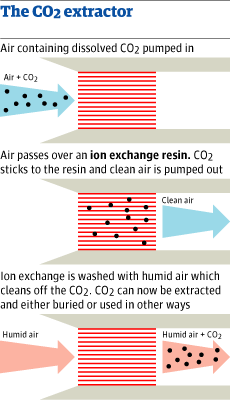Could US scientist's 'CO2 catcher' help to slow warming
- The Guardian,
- Saturday May 31 2008
It has long been the holy grail for those who believe that technology can save us from catastrophic climate change: a device that can "suck" carbon dioxide (CO2) from the air, reducing the warming effect of the billions of tonnes of greenhouse gas produced each year.
Now a group of US scientists say they have made a breakthrough towards creating such a machine. Led by Klaus Lackner, a physicist at Columbia University in New York, they plan to build and demonstrate a prototype within two years that could economically capture a tonne of CO2 a day from the air, about the same per passenger as a flight from London to New York.
The prototype so-called scrubber will be small enough to fit inside a shipping container. Lackner estimates it will initially cost around £100,000 to build, but the carbon cost of making each device would be "small potatoes" compared with the amount each would capture, he said.
The scientists stress their invention is not a magic bullet to solve climate change. It would take millions of the devices to soak up the world's carbon emissions, and the CO2 trapped would still need to be disposed of. But the team says the technology may be the best way to avert dangerous temperature rises, as fossil fuel use is predicted to increase sharply in coming decades despite international efforts. Climate experts at a monitoring station in Hawaii this month reported CO2 levels in the atmosphere have reached a record 387 parts per million (ppm) - 40% higher than before the industrial revolution.
The quest for a machine that could reverse the trend by "scrubbing" carbon from the air is seen as one of the greatest challenges in climate science. Richard Branson has promised $25m (£12.6m) to anyone who succeeds.
Lackner told the Guardian: "I wouldn't write across the front page that the problem is solved, but this will help. We are in a hurry to deal with climate change and will be very hard pressed to stop the train before we get to 450ppm [CO2 in the atmosphere]. This can help stop the train."
He added: "Our project has reached the stage where it is quite clear we can do it. We need to start dealing with all these emissions. I'd rather have a technology that allows us to use fossil fuels without destroying the planet, because people are going to use them anyway."
Scientists have been sceptical about air capture devices for carbon because of the large amounts of energy they consume. Although it is relatively easy to find chemicals that absorb CO2, it is harder to then strip the gas from the so-called sorbent for reuse. A detailed report on carbon capture from the Intergovernmental Panel on Climate Change in 2005 effectively dismissed the air capture as unworkable.
Lackner's team says it has made a significant breakthrough that massively reduces the amount of energy required to recharge the sorbent. It is reluctant to discuss details, but a US patent application obtained by the Guardian shows that it is based on changes in humidity.
The team says it can trap the CO2 from air on absorbent plastic sheets called ion exchange membranes, commonly used to purify water. Crucially, it has discovered that humid air can then make the membranes "exhale" their trapped CO2. The discovery was "some serendipity and some working out," Lackner said. "When I saw it the first time, I didn't believe it."
The team is working to build a prototype at a laboratory in Tuscon, Arizona. Run by a company called Global Research Technologies (GRT), of which Lackner is vice president of research, the laboratory unveiled a "pre-prototype" air capture machine last year, based on a different technique -rinsing trapped CO2 off the membrane with liquid sodium carbonate, and then using electricity to liberate the CO2 from the fluid.
Lackner says that device works, but the "humidity switch" could slash the scrubber's energy use tenfold. He said: "We can do it coming out carbon positive."
The team is also working on ways to dispose of the pure CO2 gas produced by each scrubber.
The patent suggests the scrubber could be connected to greenhouses, where the CO2 would boost plant growth. Or the gas could be used to grow algae, for food, fertiliser or fuel. The latter could "close the carbon loop," Lackner said.
The discovery could make the team eligible for the $25m Virgin Earth Challenge, which has pledged the money to the inventor of a way to remove a billion tonnes of CO2 from the atmosphere each year, though Lackner said he had not contacted Branson.
Wallace Broecker, the distinguished environmental scientist at Columbia University who helped Lackner set up GRT, said the air scrubber could be only way to tackle climate change.
He said Lackner was "one of the smartest guys on the planet". Broecker introduced the late Gary Comer, a billionaire entrepreneur, to Lackner and Allen Wright, an engineer who runs GRT, helped by his brother Burt. Broecker said that the Wright brothers helped to cause this problem and "now the Wright brothers are going to fix it".





No comments:
Post a Comment